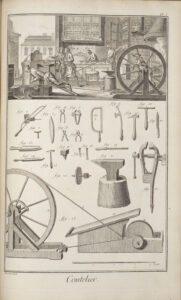Documenting the Humbler Trades
Diderot’s conception of the mechanical arts as a category of useful knowledge just as valuable as the liberal arts and sciences was a provocative challenge to long-standing prejudices against manual labor. Thought to be more hand than mind, physical work was dismissed as unreflective and unintelligent. Though not immune to these biases, Diderot sought to counter them by showing the complexity, creativity and skill of even the most humble mechanical arts.
Here the implements, products and complex processes characteristic of knife grinding, sword making, and even the cutting of corks are detailed.
In the top image apprentices carve cork stoppers while a woman sorts them; the disembodied hands shown in closeup highlight the skill requisite for even this art.
In the image to the left, the cutler adopts the inclined pose required to operate the grinding wheel, while the wheel itself is powered by another worker. Behind them, an apprentice files a razor and a woman arranges wares in a showcase.
In the image to the right, in the plumassier’s shop, hung with peacock tails and ostrich plumes, women attach feathers to the elaborate headdresses and gowns required by courtly patrons. The large feather construction in the center of the vignette is intended for an ambassador’s horse. In plates like these, the viewer was led to think not only about how but also about who made the objects in their world.



